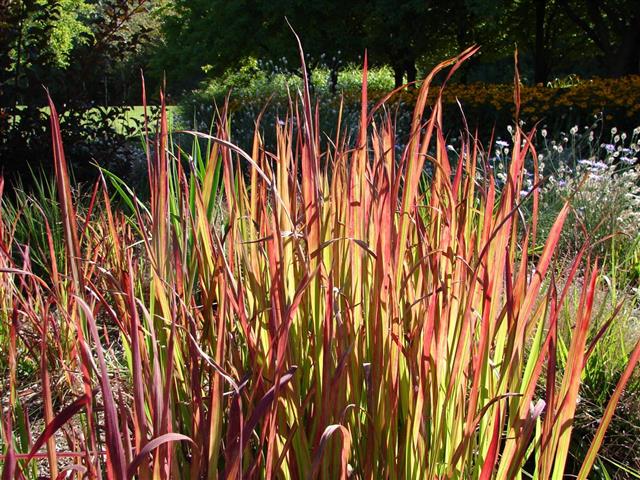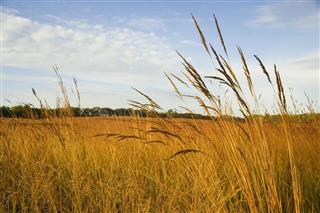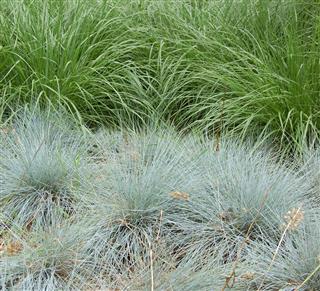
Drought tolerant ornamental grasses are characterized by narrow leaves and strong root systems. Some of the best drought-resistant ornamental grasses are blue fescue, pampas grass, big bluestem, maiden grass and cogongrass amongst others.
Various types of grasses are used in landscape designing projects. The varieties are not limited to the dwarf grasses that we grow for maintaining a uniform green lawn. In fact, some ornamental grasses reach a height of about 5-7 feet, and are grown to complement other garden components. They not only withstand fluctuating climatic conditions, but are resistant to common pest problems. And the drought tolerant ornamental grasses grow well even in dry areas with less effort.
The Best Drought Tolerant Ornamental Grass Varieties
The widespread distribution of grasses explains its hardiness to varied growing conditions. Classified under the taxonomic family Poaceae, these flowering plants are monocots and have parallel leaf venation. Although all ornamental grass types hold the reputation of low maintenance plants, they require basic growth factors, like water, light, temperature and nutrients. So, if you are residing in areas that get exposed to frequent dry spells, ensure that you select drought-resistant ornamental grasses for garden plantation.
Blue Fescue
Scientific name: Festuca glauca
Hardiness Zones: 5-9
The bluish gray foliage is a distinguishing feature of this grass cultivar. Blue fescue grows in clumps, and plant height averages 1 foot. The leaves are semi-evergreen and growth pattern is perennial. Extremely hardy to dry conditions, blue fescue is popularly planted in rock gardens and xeriscapes. You can grow this rapidly spreading grass variety as a specimen plant, groundcover and along garden beds.
Pampas Grass
Scientific name: Cortaderia selloana
Hardiness Zones: 6-10
Pampas grass is prized for its tall height (measuring about 9 feet and more), bluish-green foliage and spectacular white inflorescence. The colorful leaves are evergreen, thus adding a color interest in all seasons. Plant pampas grasses in rows, and they really look amazing. It performs in dry climate and poor soil. In many regions, growing this ornamental grass type is banned, owing to its invasive nature.
Maiden Grass
Scientific name: Miscanthus sinensis
Hardiness Zones: 4-9
Having variegated leaves, maiden arching grass is popular for creating hedges in landscaping projects. You can even think of incorporating this tall grass in the back of garden borders. Upon maturity, the plant height reaches 5 feet and slightly more. It requires partial shade to full sun, and well-drained soil for optimal growth.
Big Bluestem
Scientific name: Andropogon gerardii
Hardiness Zones: 4-9
As the name indicates, the stalk of this ornamental grass is bluish-green in color. It attains a height of approximately 4-8 feet. There is another bluestem variety called little bluestem, which maximum height is 3 feet. For both types, the bronze colored blooms are retained in the plant for a longer period. Once acclimatized to an area, it forms rhizomes and spreads profusely. Hence, it is often considered as a weed or invasive grass.
Oriental Fountain Grass
Scientific name: Pennisetum orientale
Hardiness Zones: 5-9
This mound forming ornamental grass is medium-sized (3-4 feet height), and produce whitish cream blooms in late summer. Resistant to dry areas, this ornamental grass is a performer in xeriscapes. For maintaining healthy fountain grass, grow it in fertile soil and areas that receive full sun. Avoid overwatering, as it puts the plant under stress and increases the chances of pest infestations.
Muhly Grass
Scientific name: Muhlenbergia capillaris
Hardiness Zones: 7-11
Whether you are referring to pink muhly grass or pink hair grass, they mean the same ornamental grass type. It simply looks adorable in fall, when the entire plant is covered by pink colored plumes. At maturity, pink hair grass grows to about 3-6 feet, including the plumes. An indigenous grass of the United States, you can successfully grow it in any season. It can withstand high temperature, poor soil and dry spells.
Weeping Lovegrass
Scientific name: Eragrostis curvula
Hardiness Zones: 7-9
The name of this lovegrass is coined with reference to its downward pointing leaves. It grows well in any type of soil, provided that the plant receives adequate sunlight. Maximum plant height is 3 feet, and the leave length accounts to 1 foot. Exclusively planted for foliage, yellowish blooms are borne in long stalks in late summer. The weeping lovegrass is basically grown to prevent soil erosion in slopes and roadside.
Japanese Blood Grass
Scientific name: Imperata cylindrica
Hardiness Zones: 5-9
Japanese blood grass or cogongrass is found growing in disturbed areas, where other plants cannot thrive. While young leaves of this grass variety are green, the older foliage flaunts orange brown color. The plant height measures 1-1 ½ feet, based on the cultivar and provided growth conditions. The adaptability of this grass species to drought areas is attributed to its roots, which penetrate deep in soil for collecting water.
Well, this was a list of some drought tolerant ornamental grasses. Proper site preparation, correct plantation and initial plant care are required for maintaining healthy plants. As expected, the actual guidelines for how to grow and care for ornamental grasses differ according to the selected species. Apply your gardening skills to provide the same for these grasses. After the first year, they require cutting back in spring time. So, even if you are growing grasses to create privacy, be prepared for the trimming procedure. Within 2-3 months, the ornamental grasses will reach normal size and provide screening effect.






